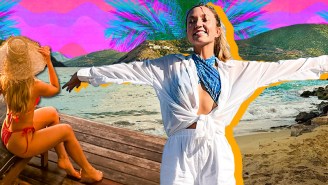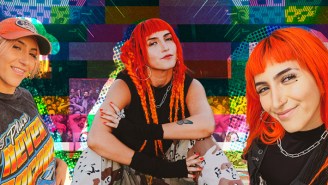Latif Nasser is well aware that a global pandemic makes a weird time to drop his new Netflix series Connected — a show in which he takes several connecting flights per episode and attempts to illustrate how we’re all inextricably linked to one another. But while Connected feels tonally discordant with the panic and angst of COVID, there’s a strange comfort in being reminded that even though the call to socially distance has changed our way of life, our connections to one another and our planet endure.
Over the course of six episodes, Nasser — the acclaimed Radiolab researcher, podcaster, and science historian — guides us through single-topic episodes that cover everything from nukes to poop. Using humor and wit to tease out larger topics, the true draw of Connected is how it opens up rabbit holes and then invites viewers to dive ever deeper. Something changes in you when you learn how the secrets to a healthy future lay in the poop of the past, or just how much good has come out of the invention of the nuclear bomb. Each episode is informative, funny, and makes a worthy watch for anyone who wants to get absolutely tripped out on science.
We spoke with Nasser over the phone the day after Connected‘s Netflix premiere.
***
Radiolab sits pretty comfortably in the audio medium, what advantages do you have entering a visual medium for Connected and what are you having the most fun with personally?
It’s a totally bizarre jump from radio to TV, there are so many parts of the documentary making toolkit that I know and I use all the time, and there are so many other parts for the visuals that I was just so dumb about. It’s been this great learning experience.
Hopefully, there are some tricks and narrative moves we use all the time on Radiolab that I’ve been able to sort of smuggle into tv.
It was the most fun to be able to play with the graphics team that I worked with. They are just so inspired, people who are touched with a gift. To commission them like “Okay, what I need is a graphic that is like the Beijing National Stadium and the Hoover Dam but smooshed together, because that’s the amount of dust that goes into the Amazon —“ or “I need a spherical theater that represents weather forecasting that’s going on in a supercomputer but its actually an orchestra” I would have these very very specific requests for them and they would come back with these dazzling beautiful gems, just cranking them out. I was so lucky to have them.
It’s one thing to explain something complicated on the radio where you don’t have a visual component, but to be able to use visuals and have a team of people that are excited and inspired and churning out these gorgeous graphics, makes the show worth watching for their graphics alone!
In addition to being a historian of science, I’ve read that you’re also a theater kid. How does that interest in theater influence the way in which you tell stories?
That’s what I studied as an undergrad and I still think that so many of those techniques and tools from playwriting have taught me that everything has to have a beginning, middle, and end. There has to be an inciting incident, there need to be obstacles, and tension, we need to have a main character, that character needs to go on a journey. I still do all of that stuff, obviously, I’m not playwriting science — in that I fact check everything — but the techniques, the dramatic structure, and dramaturgy of it.
I approach it like this: whether you’re telling true stories or whether you’re telling fictional stories, people take them the same way, they want the same things, they crave that plot and character development. Using those dramatic techniques is sort of a natural fit in the documentary world, I feel.
How do you decide which topics to explore from episode to episode? With names like “Surveillance,” “Dust,” “Poop,” it feels like an episode can be about anything and everything, but you still managed to filter it down into a tight six.
I think that’s part of the fun of TV, there are an infinite amount of options here, which is alluring and paralyzing. A few of the things I thought about when trying to get it down to the tight six, is that I wanted a nice spread. “Poop” was sort of a natural thing, that’s just a thing that I’m always interested in and will always seek out stories about. Benford’s Law was a thing that kept coming up while I was researching other stuff then it almost became like a dare, “Could you really make a 45-minute episode about a mathematical observation, it feels like there is no way to do that.” Okay yeah, we’re going to do that!
I wanted a climate change-y episode to think about, so “Clouds” kind of covers that and felt like a satisfying way to touch on that. Overall, I wanted a really nice spread to feel like we were touching all kinds of different science, sort of just to try out. It feels like a new car, you want to test out the premise of the show, you want to road test it, does it work with this kind of thing? Can I use it to talk about surveillance which is a different thing than dust?
It’s a really fun premise, such a liberating premise, almost too liberating. But it’s guided by my own excitement and curiosity and I think it led me to very different and very strange places.
That’s kind of the charm of the show, each topic is a rabbit hole that pulls you in. Let’s take “Poop” for example, I was hesitant to watch that episode, but once you learn one thing it kind of compounds into another in a fascinating way. What things have you discovered that completely blew your mind in a way you didn’t expect?
The dust story, to get a little bit personal. It was supposed to be about dust but what it ended up being was an episode about life and death and it became weirdly personal. While this was shooting I lost a friend of mine, and what was supposed to be about dust, then ended up being this meditation on life and death that was truly shocking. It’s supposed to be over here and dead and just sitting here, but its not. It moves and it fertilizes and it pollinates and it does some bad and scary stuff too.
But just the idea that things that are dead have these afterlives that are going on all around us. It was emotionally shocking for me to tell this story at a time when I had lost my friend and I was very sad about it. Revisiting this story over and over, to have to shoot it and talk to people about it and edit it, it was sort of a weird but cathartic experience.
Do you think technology and advancement will always be a double-edged sword? I think about the episode on surveillance. The way Tinder had 800 pages on Judith was chilling, but that same technology can also lead to a world where pigs and other animals are more ethically farmed, which is an important change. It’s always this give and take.
You know, that’s the story of the history of science. You can’t predict and things end up being way better or way worse than you could’ve ever imagined. That’s everything, that’s all around us. Tupperware was made from gas mask technology in World War 2, everything around us is products of this double-edged sword. We have to marvel at that. What a world we live in where all this is possible, so much is possible for the big and the bad.
First, it opens your eyes, but then it makes you realize you’re so much more responsible for the world around us and the way we use all of these things.
Given the title of the show and this new era of social distancing, how do continue to stay connected while living through this unprecedented time where we have to be disconnected from one another for our own safety?
Yeah, it’s a funny moment right? It feels like an especially strange moment to release a show out in the world that is about those connections, dwelling on those connections. It’s me taking these connected flights all over the world to report these stories, and it’s coming out to this world that’s kind of shut down. My family is in Canada, we’re shut down. We’re all shutdown in our homes, there is this profound irony, but it makes me think, “we think these things are shut down, but we’re kidding ourselves.”
There are these connections, they exist. No matter what we do the world is going to be this connected place, it’s going to surprise us the ways in which it is. For COVID that’s a scary thing because there is a danger there, but I do think that hopefully, the idea of this show is to say “Look, the world isn’t just connected in the way you think it is, it’s connected in all these other ways too”
“Connected” Is Available To Stream Now On Netflix.







